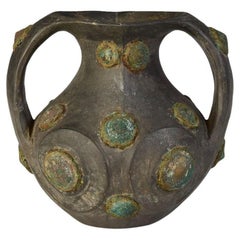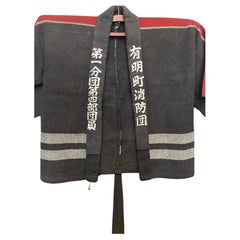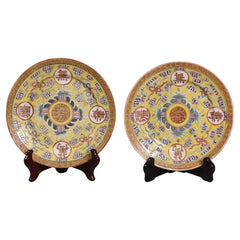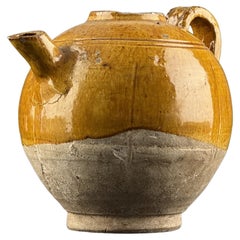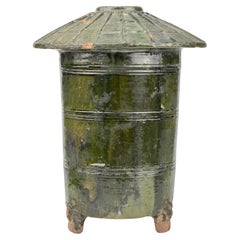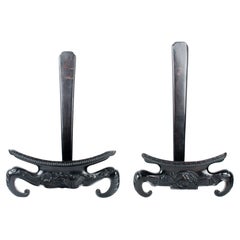East Asian Antiquities
to
334
565
288
1,316
13
5
4
3
2
2
1
1
1
1
480
410
426
18
212
46
61
23
3
9
3
3
4
7
6
15
2
562
294
284
248
157
1,880
1,334
741
388
379
1,334
1,331
1,331
10
3
3
2
1
Place of Origin: East Asian
Han Dynasty, Rare Antique Chinese Pottery Amphora Decorated with Bronze Ornament
Located in Sampantawong, TH
Rare antique Chinese pottery amphora decorated with bronze ornament.
In the past, this kind of vessel was used for wine container.
Age: China, Han Dynasty, B.C. 206 - A.D. 220
Size...
Category
15th Century and Earlier Antique East Asian Antiquities
Materials
Pottery
Japanese Antique Sashiko Banten FireFighter Jacket Ariake 1960s
Located in Paris, FR
This Sashiko b(h)anten was made around 1960 in Showa era in Japan.
On the front, it is written 'Member of Vigilance Committee Ariake ' in Japanese. On the back, it is written 'ariak...
Category
Late 20th Century Showa East Asian Antiquities
Materials
Cotton
pair of Chinese porcelain plates, 19th c.
Located in New York, NY
decorated with Chinese characters on yellow ground
Category
Late 19th Century Antique East Asian Antiquities
Materials
Porcelain
$1,500 / set
Amber-Glazed Pottery Ewer, Tang-Liao Dynasty (7-12th Century)
Located in seoul, KR
This historical piece features a robust, rounded body with a broad shoulder tapering down to a narrower base. The glaze, characterized by its rich amber hue, covers most of the vessel, while the lower part remains unglazed, exposing the rough, textured clay beneath.
Date : Tang-Liao Dynasty(7-12th century)
Type : Amber-glazed pottery
Provenance : Acquired in late 1990s from Hongkong
Reference :
1) Christies Newyork 1–15 DEC 2015 - Exquisite Splendor: Chinese Ceramics And Works Of Art - Lot 49
(Price realised : 5,250 USD / Type : Closely related)
2) Christies Newyork 18–27 MAR 2015 - The Collection of Robert Hatfield Ellsworth...
Category
15th Century and Earlier Tang Antique East Asian Antiquities
Materials
Pottery
$2,394 Sale Price
40% Off
Funerary Model of a Granary, Han dynasty
Located in seoul, KR
Cylindrical vessel on three animal-shaped feet (dragon or snake), wall with profile grooves, roof. Ceramic with green transparent glaze. "Iridescence" is observed in surface.
Period...
Category
15th Century and Earlier Han Antique East Asian Antiquities
Materials
Stoneware
$2,242 Sale Price
25% Off
A Pair of Chinese Zitan Charger Stands, 19th Century
Located in Savannah, GA
A pair of Chinese zitan wood charger or bowl stands, 19th century.
From the estate of Ira and Nancy Koger.
11 ½ inches wide by 7 inches deep by 15 ½ inches tall; 5 ⅝ inches dept...
Category
19th Century Antique East Asian Antiquities
Materials
Zitan
Japanese Antiques Primitive Art wood Shrine for Buddhist statues
Located in Niiza, JP
1200(W)× 860(H) × 250(D) [mm] 10kg
Estimate packing size(Packed in 4-5mm plywood): W135cm H100cm D40cm 22kg
A soot-covered shrine thought to be from the Edo period
It is for home u...
Category
18th Century Antique East Asian Antiquities
Materials
Wood
Ming Dynasty Green-Glazed Horse and Rider (15-16th Century)
Located in seoul, KR
Statues of Chinese horse and rider, featuring glazes in green, amber, are set on rectangular bases.
Period: Ming Dynasty
Medium: Green-glaze...
Category
15th Century and Earlier Ming Antique East Asian Antiquities
Materials
Pottery
China 618-907 AD Tang Dynasty Pair Of Polychromate Earth Spirits Zhenmushou
Located in Miami, FL
Pair of Earths Spirits "Zhenmushou" from the China Tang Dynasty 618-907 AD.
A beautiful and rare pair of "Earths Spirits guardians" from the Yunnan province region in the ancient China. This was created in clay earthenware pottery during the Tang Dynasty period between 618 and 907 AD. Featuring the molded figures of two seated guardians with decorations with polychrome pigmentations. The figures are seated on their haunches with cloven hooves planted firmly on the base looking forward with their front legs in a straight position. Both with face and body alert expressions on a rectangular base.
Earth spirits usually appear in pairs, one with a human head and the other with a lion head. Their supernatural powers, indicated by antlers, spiky flanges and flames, enable them to confront evil spirits and protect any precincts within their gaze. Have been believed to protect the living by keeping the spirits of the dead from inappropriately roaming the world outside the tomb.
Zhenmushou or guardian deities, developed from a line of protective spirits found normally in pairs at the front of Tang dynasty tombs. They served both to protect the figure from untoward spirits, and the outside world from the roving spirit of the dead. Combining features from a number of animals to form the perfect mythic beast, these mythical creatures were perceived to be the ideal guardians of the dead
The semi human faced figure has a measures of 11.25 by 4.5 by 5.75 inches (28.57 x 11.43 x 14.60 Cm).
The mythological lion animal figure has a measures of 10 by 5 by 5.8 inches (24.5 x 12.7 x 14.73 Cm).
Tang dynasty or Tang Empire, was an imperial dynasty of China that ruled from 618 to 907, with an interregnum between 690 and 705. It was preceded by the Sui dynasty and followed by the Five Dynasties and Tend Kingdoms period. Historians generally regard the Tang as a high point in Chinese civilization, and a the golden age of cosmopolitan culture. Tang territory, acquired through the military campaigns of its early rulers, rivaled that of the Han dynasty.
The Li family founded the dynasty, seizing power during the decline and collapse of the Sui Empire and inaugurating a period of progress and stability in the first half of the dynasty's rule. The dynasty was formally interrupted during 690–705 when Empress Wu Zetian seized the throne, proclaiming the Wu Zhou dynasty...
Category
15th Century and Earlier Tang Antique East Asian Antiquities
Materials
Earthenware, Pottery
$4,312 Sale Price / set
25% Off
Japanese Antiques Tanaka Kosai Striped Flower Basket Bamboo Basket
Located in Niiza, JP
φ360× 105(H) [mm]
Box size:Box size: φ370×140mm 2kg
The Oita Prefectural Art Museum also has similar collections of woven baskets by Kosai.
The unique design makes it immediately re...
Category
20th Century East Asian Antiquities
Materials
Bamboo
Sancai-glazed ‘floral’ dish, Liao dynasty(916~1125)
Located in seoul, KR
Well potted with shallow sides rising from a short foot, the interior molded with a single chrysanthemum surrounded by peony blossoms picked out in yellow and with green leaves again...
Category
15th Century and Earlier Tang Antique East Asian Antiquities
Materials
Pottery
$3,495 Sale Price
50% Off
pair of Chinese porcelain cover boxes, 19th c.
Located in New York, NY
floral motif
Category
Late 19th Century Antique East Asian Antiquities
Materials
Porcelain
$10,000 / set
Two Incised Sandstone Mingqi, Five Dynasties and Ten Kingdoms period(907-979)
Located in seoul, KR
Figures from this era tend to be simpler and more utilitarian, reflecting the instability and regional diversity of the time. These pottery figures often unglazed or painted with bas...
Category
15th Century and Earlier Antique East Asian Antiquities
Materials
Sandstone
$1,176 Sale Price
30% Off
Pair of Early 20th Century '1900s' Chinese Cloisonné Enameled Porcelain Vases
Located in North Miami, FL
Behold a remarkable pair of early 20th-century Chinese cloisonné enameled porcelain vases, harkening from the 1900s. These vases are a ...
Category
Early 20th Century East Asian Antiquities
Materials
Enamel
$7,665 Sale Price
30% Off
Japanese navy blue yukata with stripped pattern 1980
Located in Paris, FR
This is a cotton jacket which was made in Japan in Showa era around 1980s.
A yukata (浴衣, lit. 'bathrobe') is an unlined cotton summer kimono, worn in casual settings such as summer ...
Category
Late 20th Century Showa East Asian Antiquities
Materials
Cotton
10th - 12th Century, Song Dynasty, A Pair of Antique Chinese Pottery Lion Panel
Located in Sampantawong, TH
A pair of Antique Chinese pottery lion panel with stand.
Age: China, Song Dynasty, 10th - 12th Century
Size excluding stand: Height 23.6 - 24.3 C.M. / Width 18.8 - 20.5 C.M. / Thick...
Category
15th Century and Earlier Antique East Asian Antiquities
Materials
Pottery
Chinese double gourd porcelain vase, 18th c.
Located in New York, NY
blue glazed multi-lobed double gourd vase; 2.2in(D) x 2.2in(W) x 4.25in(H) are the dimensions of the porcelain vase only (not including the wooden base); the wooden base shown in the...
Category
Late 18th Century Antique East Asian Antiquities
Materials
Porcelain
carved Chinese lobed hardwood stand, 19th c.
Located in New York, NY
decorated with a fitted, lobed marble inlay
Category
Late 19th Century Antique East Asian Antiquities
Materials
Hardwood
Qing Dynasty an Antique Chinese Carved Jade Figure of a Bullock
Located in Brea, CA
A Qing dynasty Chinese carved jade figure of a bullock. 13 cm x 6cm x 5 cm. weight 600g see more pictures.
Category
19th Century Qing Antique East Asian Antiquities
Materials
Jade
Chinese Qing porcelain plate, tray, Fitzhugh pattern, British East India Company
By Margaret Fitzhugh Browne
Located in Valladolid, ES
Technical data
Materials: Porcelain tray, wooden legs
Period: Qing Dynasty
Country of origin: China
Good condition for its age and use, with some flaws in the wooden structure
Overall dimensions: 70 x 95 x 80 cm
Porcelain dimensions: 70 x 58 cm
Exquisite Fitzhugh pattern porcelain plate or tray, inlaid in a cabinet that highlights its oval profile and raised on four slightly curved square legs.
The term "Fitzhugh" refers to a type of Chinese export porcelain produced primarily between 1780 and 1840, featuring blue and white designs. It originated with three members of two generations of the Fitzhugh family. Members of this family held important positions as ship captains and even as directors in the British East India Company. Within this company, high-ranking officials were allowed to engage in private trade. Between 1704 and the 1790s, porcelain pieces bearing this pattern were shipped to England.
The design usually includes a central medallion, although it is occasionally replaced by a coat of arms or monogram. The medallion is surrounded by four groupings of flowers representing the four seasons—peony for spring; lotus for summer; chrysanthemum for autumn; and prunus for winter—and symbols that typically represent the four virtues of the Chinese scholar: music, painting, logical thinking, and calligraphy. The design is framed with a decorative border that may be a lattice and spearhead pattern, sometimes known by the term "Nanking," or a more elaborate border featuring butterflies, honeycomb shapes, and floral ornamentation. The definition of the Fitzhugh porcelain...
Category
1790s Chinese Export Antique East Asian Antiquities
Materials
Porcelain, Wood
pair of Chinese tri-lobed ruby red porcelain vases, 19th c.
Located in New York, NY
double gourd vases decorated with a gold colored bow
Category
Late 19th Century Antique East Asian Antiquities
Materials
Porcelain
Kamakura Period Japanese Shinzu Sculpture
Located in Hudson, NY
Kamakura Period Japanese Shinzu sculpture. Shinzo is a representational figure of a god or spirit in the Shinto religion. This sculpture was carved fro...
Category
15th Century and Earlier Antique East Asian Antiquities
Materials
Wood
Chinese clair-de-lune porcelain vase, 19th c.
Located in New York, NY
decorated with two stylized handles
Category
Mid-19th Century Antique East Asian Antiquities
Materials
Porcelain
Song Dynasty, Antique Chinese Pottery Brick Tile with Musician Flute Player
Located in Sampantawong, TH
Antique Chinese pottery brick tile with musician flute player.
Age: China, Song Dynasty, 10th - 12th Century
Size excluding stand: Height 27 C.M. / Width 16.2 C.M.
Height including ...
Category
15th Century and Earlier Antique East Asian Antiquities
Materials
Pottery
Impressive Terracotta Funerary Procession - Ming Dynasty, China '1368-1644 AD'
Located in San Pedro Garza Garcia, Nuevo Leon
Impressive Funeral Ensamble of 10 Terracotta Glazed Figures in green and caramel colors depicting a votive procession with a palanquin, his four carriers, a horse, a stableman, two musicians, and an offering carrier.
This ensemble is accompanied by a Certificate of Authenticity, and Certificate of Expertise by Jean-Yves Nathan - Specialist in Asian Arts for the CEDEA (The European Confederation of Art Experts).
Burial figurines of graceful dancers, mystical beasts, and everyday objects reveal both how people in early China approached death and how they lived. Since people viewed the afterlife as an extension of worldly life, these figurines, called mingqi, sometimes referred as “spirit utensils” or “vessels of ghosts” disclose details of routine existence and provide insights into belief systems over a thousand-year period.
The Ming dynasty was the ruling dynasty of China – then known as the Empire of the Great Ming – for 276 years (1368–1644 AD). Founded by Chu Yuan-chang, the rebel leader that was successful in removing the mongols from the throne. Chinese control was re-asserted in China and eastern Asia. Literature became more important, schools were created, and the justice system was reformed. The Ming dynasty is described by some as "one of the greatest eras of orderly government and social stability in human history,” was the last imperial dynasty in China ruled by ethnic Han Chinese.
The practice of burying ceramic objects with the deceased went into decline from the 10th to the 14th Century AD. There was a revival in placing miniature representations of glazed terracotta objects such a furniture, food offerings, horses, miniature statues...
Category
15th Century and Earlier Ming Antique East Asian Antiquities
Materials
Terracotta
Green-glazed model of a shrine, Han dynasty
Located in seoul, KR
It has a pyramidal roof topped with a finial, ornamental ridges, and faux doors and windows that are characteristic of Chinese sacred architecture of the period.
Period : Han Dynast...
Category
15th Century and Earlier Han Antique East Asian Antiquities
Materials
Stoneware
$2,992 Sale Price
25% Off
Japanese Porcelain Small Incense Burner 1970s Flowers
Located in Paris, FR
This is an incense burner which was made in Japan around 1970s in Showa era. This incense burner is made with porcelain.
Dimensions: 6 x 6 x H8 cm
Category
1970s Showa Vintage East Asian Antiquities
Materials
Porcelain
Eight Antique Chinese Tobacco Pipe Holder Antrophomorphic Subject, Tobacco Curio
Located in Leuven , BE
Eight Antique Chinese Tobacco Pipe Holders with Antrophomorphic Subject, made of the Wood of Fruit Trees.
French Private Collection.
Category
19th Century Antique East Asian Antiquities
Materials
Fruitwood
Early 18th Century miniature Chinese Porcelain Tea Bowls with Saucers, Kangxi
Located in Delft, NL
Early 18th Century miniature Chinese Porcelain Tea Bowls with Saucers, Kangxi
6 Miniature Chinese porcelain tea bowls with saucers
Kangxi Period (1662-1722)
6 Tea bowls and saucers ...
Category
Early 18th Century Antique East Asian Antiquities
Materials
Porcelain
Japanese Antiques a basket by Chikuryu-sai Yamamoto(山本竹龍齋) lotus Bamboo
Located in Niiza, JP
Material: lotus and bamboo
Made by Yamamoto Chikuryusai,
a bamboo craftsman from Osaka Prefecture.
Chikuryusai took the name "Yamamoto Shoen 山本笙園"
in his later years.
Because he...
Category
1920s Vintage East Asian Antiquities
Materials
Bamboo
Momoyama Namban Chest
Located in PARIS, FR
Namban chest with a semi-cylindrical lid made of black lacquered wood (urushi) with gold lacquer (maki-e) and inlaid with mother-of-pearl (raden).
Decorated with three main bands o...
Category
17th Century Antique East Asian Antiquities
Materials
Lacquer
$41,625
Japanese Antiques Keizo Yagisawa (Sokan) A Flower Basket Bamboo Craft with Box
Located in Niiza, JP
A bamboo craft artist who studied under Living National Treasure Katsushiro Souho.
Established the "Yagisawa Bamboo Workshop" in Otawara, Tochigi Prefecture
Specializes in detailed m...
Category
20th Century East Asian Antiquities
Materials
Bamboo
Nineteenth Century Chinese Water Pipe in Paktong
Located in Leuven , BE
Nineteenth century Chinese water pipe in Paktong (= an Alloy of Zinc, Copper and Nickel). The Base - elaborated in Enamel Cloisonné - is decorated with a Phoenix on an Ultramarine Bl...
Category
19th Century Antique East Asian Antiquities
Materials
Copper, Zinc
Taoist dignitary statue - ancestor reliquary - lacquered wood - China Qing 19th
Located in Beuzevillette, FR
Superb old Taoist statue in polychrome and gold lacquered wood, representing a Dignitary seated on a throne, armchair. It is carved from solid wood, with...
Category
Early 19th Century Qing Antique East Asian Antiquities
Materials
Wood
Chinese Painted Stucco Head of a Luohan, Song Dynasty, 11th Century, China
Located in Austin, TX
A remarkable Chinese life sized painted stucco head of a luohan, Song, Liao or Jin Dynasty, circa 11th century, China.
The amazingly life-like figure depicts a luohan (sometime spelled lohan), also known as an arhat, one of the original disciples of the Buddha. The elderly man has been molded in stucco with inset glass eyes and painted with idealized, if slightly exaggerated features.
The unidentified luohan sports a bald, or perhaps shaved, domed head above a bulging forehead, symbolizing his vast wisdom. The wrinkles in his furrowed brow, and creases around his eyes add to his realism. The learned man stares out wisely from deep set, heavily lidded inlaid glass eyes that catch the light.
The luohan has high cheekbones and a prominent jawline. His lips full and pursed as if about to speak. The corners of his mouth turned up ever so slightly in a faint smile, causing his gaunt cheeks to dimple charismatically. A series of dots above the upper lip indicate he may originally have sported a mustache of real hair.
This life sized head with extremely realistic features fits into a very narrow time frame of Chinese Buddhist art. Perhaps the most recognized group of large, finely molded Chinese luohan...
Category
15th Century and Earlier Antique East Asian Antiquities
Materials
Glass, Stucco
Tang Dynasty, Antique Chinese Painted Pottery Horse and Rider
Located in Sampantawong, TH
Antique Chinese painted pottery horse and rider.
Age: China, Tang Dynasty, A.D. 618 - 907
Size excluding stand: Height 36 C.M. / Width 9.7 C.M. / Length 31.6 C.M.
Condition: Well-pr...
Category
15th Century and Earlier Antique East Asian Antiquities
Materials
Pottery
Exquisite Vintage Chinese Calligraphy Brush - 15”.5 x 1.5
Located in Delray Beach, FL
Capture the essence of traditional artistry with this truly remarkable vintage Chinese calligraphy brush. More than just a writing instrument, this piece is a testament to timeless...
Category
20th Century East Asian Antiquities
Materials
Stone
Antique Asian Water Pipe Yellow Copper, Tortoiseshell Scale, Tobacco Collectible
Located in Leuven , BE
Antique Chinese Water Pipe in Yellow Copper, decorated with Tortoiseshell Scales. The Rectangular Base gives this Object its Elegance.
French Private...
Category
19th Century Antique East Asian Antiquities
Materials
Copper
Large Size Chinese Rose Medallion Porcelain Plater, Ric 059
Located in Norton, MA
A truly fine hand-painted medium-sized porcelain and very large Plater from the 19th century.
Category
19th Century Qing Antique East Asian Antiquities
Materials
Porcelain
Japanese Antique Wooden Bowl 1910s-1940s Primitive Wabi-Sabi
Located in Chiba, Chiba
This is a Japanese wooden bowl.
It is a folk craft that was used in daily life.
I don't know what kind of wood it's made of, but it's sturdy.
Since it is made by hand, it has a dist...
Category
Early 20th Century East Asian Antiquities
Materials
Wood
$300 Sale Price
40% Off
Chinese Qing Pair Hand Painted Peking Glass Onion Shape Vases
Located in Bishop's Stortford, Hertfordshire
A fine and unusual pair antique Chinese Qing Peking glass vases finely hand decorated with landscape panels dating from the 19th century or possibly earlier. The vases are blown in a...
Category
19th Century Qing Antique East Asian Antiquities
Materials
Glass
Japanese Antiques primitive Japanese oak a wooden frame for hearth
Located in Niiza, JP
Wood: Japanese oak
a wooden frame for hearth
φ880× 50 (thickness) [mm] 12kg
In ancient Japan, people gathered around the hearth to eat and other things
It would also look great as a...
Category
18th Century Antique East Asian Antiquities
Materials
Wood
Japanese Silk Haori Jacket Red-Orange Hanaguruma 1970s
Located in Paris, FR
This is a silk jacket which was made in Japan.
It was made in Showa era around 1970s.
The haori is a traditional Japanese hip- or thigh-length jacket worn over a kimono. Resembling ...
Category
Late 20th Century Showa East Asian Antiquities
Materials
Silk
Tibetan Buddha Sakyamuni Statuette 19th Century
Located in Milano, IT
Prince Gautama Siddhartha was the son of Mayadevi and Suddhodana, king of the Sakya of Kapilavastu. At court, young Siddhartha led a joyful and carefree life, married Yasodhara and h...
Category
19th Century Tibetan Antique East Asian Antiquities
Materials
Bronze
$1,427 Sale Price
20% Off
Early 20th Century Chinese Wooden Rice Measure with Copper Fittings
Located in Auribeau sur Siagne, FR
Early 20th Century Chinese Wooden Rice Measure with Copper Fittings – Collectible with Rich Patina
Description:
This authentic Chinese rice measure, crafted in wood with copper and blackened metal fittings, dates from the early 20th century and was traditionally used for measuring and transporting rice. Featuring hand-assembled wooden planks joined with metal corner reinforcements, this piece displays a rich brown patina that testifies to its age and use. A functional tool of rural Chinese life, it now stands as a beautiful decorative object or collector's piece, ideal for adding authentic character and cultural depth to an interior.
Key features include:
Traditional Chinese Craftsmanship: Constructed with fine wooden planks, joined and stabilized with blackened metal brackets and copper fittings, this measure showcases practical design rooted in vernacular tradition.
Warm Natural Patina: The deep brown wood tones and aged copper highlights reveal a beautiful oxidation and surface wear, offering an aesthetic of timeworn authenticity.
Early 20th Century Origin: Made in China in the early 1900s, this piece reflects a period when such tools were essential daily implements—now repurposed as vintage decor.
Versatile Decorative Use: Perfect as a sculptural centerpiece, storage box, or planter base, it adds texture and history to both rustic and modern interiors.
Collector’s Appeal: A sought-after item for collectors of antique Asian objects, particularly those interested in domestic cultural heritage pieces.
Solid & Sculptural Form: With its boxy shape and visible joinery, the piece feels both grounded and graphic, bringing architectural strength to its setting.
This Chinese rice measure is more than a historic vessel—it’s a symbol of cultural heritage, honest craftsmanship, and functional beauty, ready to enrich contemporary spaces with vintage soul.
Keywords: antique Chinese rice measure, early 20th-century wooden vessel, vintage Asian storage box...
Category
Early 20th Century Chinese Chippendale East Asian Antiquities
Materials
Metal
Vintage Chinese Porcelain Plate, Made in China, Early 20th Century
Located in Roma, IT
This porcelain plate is an original decorative object realized in China by Chinese manufacture, at the beginning of the 20th century.
It is decorated with geometric and floral or...
Category
Early 20th Century East Asian Antiquities
Materials
Ceramic
Antique Japanese Decorative Wall Dish
Located in Milano, IT
Round plate in bronze and cloisonné enamel designed in Japan at the end of the 19th century, during the 'Meiji' era, which can be translated as 'enlightened government'. This histori...
Category
Early 1900s Anglo-Japanese Antique East Asian Antiquities
Materials
Bronze
$761 Sale Price
20% Off
Qing Ching Dynasty 1821-1850 Porcelain Enamel Double Mouth Chinese Vase
Located in Louisville, KY
This stunningly enameled porcelain vase has a double mouth opening with hand-painted images of boys playing among the vines, gourds and gourd blossoms. There is a border of bat-like ...
Category
Early 19th Century Qing Antique East Asian Antiquities
Materials
Porcelain
Antique Small Chest of Drawers from Edo period 19th Century, Japan
Located in Tokyo, Tokyo
Antique small chest of drawers from Edo period (1603-1868), Japan.
If you look closely at the top surface, you can see writing on it.
...
Category
19th Century Antique East Asian Antiquities
Materials
Iron
"Usu", Hande-carved, Wabi-sabi, Early 20th Century, Japan
Located in Tokyo, Tokyo
"Usu" is one of the traditional tools with a rich history, representing an important aspect of Japanese culture, especially in culinary arts. Typically, it consists of a large wooden...
Category
Early 20th Century Folk Art East Asian Antiquities
Materials
Wood
pair of Chinese turquoise glazed porcelain vases, 19th c.
Located in New York, NY
body decorated with phoenix motif
Category
Late 19th Century Antique East Asian Antiquities
Materials
Porcelain
"Usu", Hande-carved, Wabi-sabi, Early 20th Century, Japan
Located in Tokyo, Tokyo
"Usu" is a traditional Japanese tool with a deep cultural significance, particularly in the culinary arts. This unique item typically features a large wooden or stone bowl with a fla...
Category
Early 20th Century Folk Art East Asian Antiquities
Materials
Wood
18th Century Chinese Porcelain Dollhouse Miniatures Blue and White Vases
Located in Delft, NL
18th Century Chinese Porcelain Dollhouse Miniatures Blue and White Vases
Two miniature Chinese porcelain dollhouse vases. Chinese porcel...
Category
18th Century Antique East Asian Antiquities
Materials
Porcelain
Japanese Kimono-Diamond Pattern
Located in Paris, FR
Kimono designs featuring diamond-shaped (hishi-gata) patterns in the 1980s blended traditional Japanese motifs with modern aesthetics. The hishi pattern is a classic Japanese design ...
Category
Late 20th Century Showa East Asian Antiquities
Materials
Silk
19th Century Chinese Export Silver Two-Handle Cup & Cover, Luen Wo, circa 1880
By Luen Wo
Located in Royal Tunbridge Wells, Kent
Antique 19th century Chinese export solid silver presentation cup and cover, of traditional urn shape, the body is embossed with beautiful scenes in relief depicting Chinese nobility...
Category
19th Century Chinese Export Antique East Asian Antiquities
Materials
Silver
Japanese Silk Haori Jacket Shibori Green 2000s Heisei
Located in Paris, FR
This is a silk jacket which was made in Japan.
It was made in Heisei era around 2000s.
The haori is a traditional Japanese hip- or thigh-length jacket worn over a kimono. Resembling...
Category
Early 2000s Showa East Asian Antiquities
Materials
Silk
Chinese Hongshan Style Red Jade Sun God Carving
Located in Houston, TX
A Chinese Hongshan style carved red jade sun god. These early jade style carvings were typical ceremonial burial pieces of the Neolithic period and Hongshan c...
Category
Late 20th Century East Asian Antiquities
Materials
Jade
Han Dynasty, Antique Chinese Green Glazed Pottery Jar
Located in Sampantawong, TH
Antique Chinese green glazed pottery jar.
Lead glaze with copper is the main colorant used in Han period to produce green glaze.
Greenware b...
Category
15th Century and Earlier Antique East Asian Antiquities
Materials
Pottery
Japanese Sashiko Banten Member of Vigilance Committee 'Umezonocho', 1920s
Located in Paris, FR
This Sashiko b(h)anten was made around 1920-1926 in Taisho era in Japan.
On the front, it is written 'Member of Vigilance Committee Umezonocho ' ...
Category
1920s Taisho Vintage East Asian Antiquities
Materials
Cotton
Pair of Chinese Hexagonal Vases 19th Century Qing Dynasty 60 cm High
Located in Milano, MI
Pair Nineteenth Century Quing Dynasty Hexagonal Chinese Vases decorated in polychrome with peonies and birds with two handles formed by fruit and racemes. In the sides, vertically, w...
Category
Late 19th Century Qing Antique East Asian Antiquities
Materials
Porcelain
Recently Viewed
View AllMore Ways To Browse
Large Chinese Celadon Pots
Khmer Torso
Ancient Luristan Bronze
Chinese Terracotta Army Warriors
Cloisonne Pots Bonsai Trees
Greco Bactrian
Han Dynasty Amphora
Han Dynasty Court Lady
Palanquin Handles
Sancai Phoenix
Schist Gandharan Buddha
Bactrian Stone
Chinese Coconut Cup
Han Dynasty Chinese Cocoon Jar
Han Dynasty Cocoon Jars
Han Dynasty Pig
Khmer Goddess
Kojima Shoten
